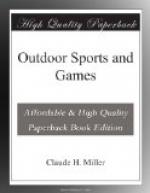To study the animal life under the surface of a clear and shallow lake, a water telescope is a great aid. It is simply a wooden box a foot or so long and open at both ends. The inside should be painted black to prevent cross reflection of light. A square of clear glass should be fitted into one end and puttied tight to keep out the water. To use the water telescope, we simply shove the glass end under water and look into the box. A cloth hood or eye piece to keep out the outside light will make it more effective. The best way to use a water telescope is to lie in the bottom of a boat which is drifting about, and to look through the telescope over the side. As you study the marvellous animal and plant life that passes along under you like a panorama, see to it that in your excitement you do not fall overboard as a boy friend of mine once did.
The care of an aquarium is a never ending source of interest to the nature student. If a boy is handy with tools he can build one himself. It is by no means an easy task however to make a satisfactory water-tight box with glass sides, and my advice is not to attempt it. Glass aquaria may be bought so cheaply that it is doubtful if you can save any money by making one at home. If you care to try it, this is the way it is usually done:
Use a piece of seasoned white wood 1-1/4 inches thick for the bottom. If you wish your aquarium to be, say, 16 inches wide and 30 inches long, this bottom board should be 20 x 34 to give a margin at the edge. The size of a home-made aquarium can be anything that you desire. It is customary to allow a gallon of water to each three-inch gold fish that will inhabit it. By multiplying the three dimensions, length, width and height of your box and by dividing your result, which will be in cubic inches, by 231 (the number of cubic inches in a gallon) you can tell how many gallons of water it will hold. Of course the rule for gold fish is not absolute. The nature student will probably have no gold fish at all. They are not nearly so interesting as our native kinds. Besides nearly all varieties of fresh water fish will either kill gold fish or if they are too large to kill will at least make life so miserable for them that to keep them together is cruelty to animals. If we keep in our aquarium the specimens that we collect in our neighbourhood, beetles, newts, crawfish, snails, and tiny sunfish the number may be greatly increased. Overcrowding however is very bad. The ideal we should strive for is not “how many specimens” but “how many kinds” we can have in our collection.
The white wood board should have three or four hardwood cleats screwed to the bottom to prevent warping. The corner pieces of our glass box may either be made of sheet copper or heavy tin, or of wood, if we cannot work in metals. The wooden strips and the bottom board should have grooves ploughed in them to hold the glass. All the woodwork should be given several coats of asphalt varnish and to further waterproof it and as a final coat use some kind of marine copper paint that is used to coat the bottoms of vessels. Never use the common white lead and linseed oil paint for an aquarium.




